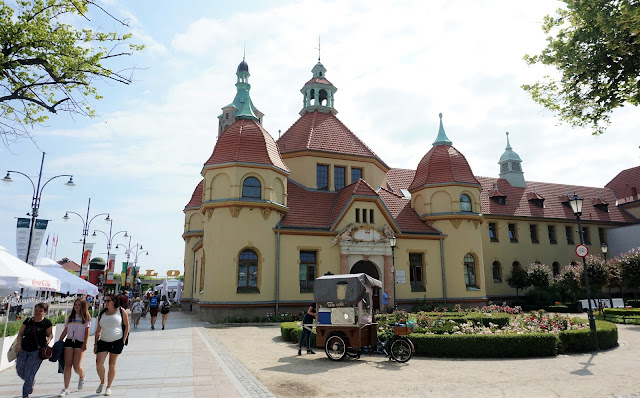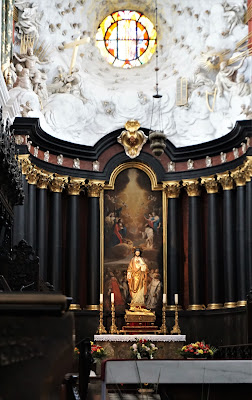June 21, 2019
Our second day in Poland was spent touring the resort cities of Sopot and Gdynia, both located north of Gdansk on the Baltic shoreline. I would compare them to California's Malibu and Laguna Beach--beautiful, indulgent places where the wealthy vacation.
Sopot is marked on the map below with a red pin, about mid-way between Gdynia and Gdansk:
Our guide called Sopot, which is less than 10 miles from Gdansk, "the Polish Riviera." I can see why the Polish elite would want to spend their summers here:
One of the most famous hotels in Poland, and indeed in Europe, is Sopot's Grand Hotel. Built in the 1920s, it was THE place to stay for the rich, famous, and important. Its most infamous guests include Adolf Hitler and Herman Göring. (I wouldn't want to stay in the rooms they slept in, would you?) Over the years, other guests have included King Alfonso XIII of Spain, Fidel Castro, Charles De Gaulle (although he complained that the beds were too short for his 6' 5" frame), Greta Garbo, Vladimir Putin, Reza Shah Pahlavi (the Shah of Iran), and Omar Sharif.
Here is the street view:
Originally, each sink in the hotel had four faucets, two for regular water and two for sea water. The water here was/is believed to have miraculous health benefits.
It has a gorgeous beach with fine-grained sand, as nice as any beach in Southern California:
However, it also has swans that putt around in the water. We don't have swans in SoCal.
Sopot boasts the longest wooden wharf in Europe: 1,678 feet. The original, shorter structure was built in 1827, and over the years it was incrementally lengthened to its present length, achieved in 1928. We took a leisurely stroll to the end:
. . . passing by hundreds of boats moored near the shore:
A pirate-style wooden ship stood proudly near the end:
Looking back towards the shore:
We went to the top of this tower to get a view of the city and to try out some Polish lody (ice cream):
While we were there, we took a sip of Sopot's famous 70-million-year-old water (very, very salty) and were cured of all our health issues, along with any wrinkles or personality disorders.
But this building, known as Krzywy Domek (Polish for "crooked house") is unlike any other place we've been to in Europe. It was built in 2004 and is part of a shopping center. It looks like something in Disneyland:
We also got a good view of the city. About a quarter of a million people live in Gdynia, and it is considered to be one of the best places to live in the country. It is known for its architectural style, called "Gdinya Modernism" (aka "The Ship Style"), that is marked by rounded corners, rounded balconies, and light colors.
A huge steel cross stands on top of the stone mountain and can be seen by ships on the Baltic:
The interior is a dramatic combination of black wood, white walls, and gold trim. I was intrigued by the cottony clouds behind the altar. Are those birds flying around in the fluff?
Zoom in . . .
. . . and a little more, and you'll see that those spots are the faces and wings of cherubs:
And there is Peter jangling his over-sized keys:
Down below these figures is a statue of Christ surrounded by twelve Corinthian columns:
The nave is very, very, very long--351 feet--making it the longest Cistercian church in the world.
There are 23 Baroque and Rococo altars in this cathedral, many dating to the 17th century:
There is lots of Renaissance-y art sprinkled throughout:
I was drawn to this painting of Judas kissing Jesus at the Garden of Gethsemane:
The crown jewel of the Oliwa Cathedral is its organ, originally constructed between 1763 and 1788. At that time it contained 5,100 pipes, 83 registers, 3 keyboards, and 14 bellows. It was the largest organ in the world. It has been reconstructed several times, adding more pipes, registers, keyboards, and frou-frou, with the last reconstruction taking place in the 1960s. Our guide told us it now has 110 registers and 7,678 pipes that range from the size of a matchstick to 10 m (33 ft):
One of the unique things about this organ is that it has moving parts, such as carved birds that tweet, actual bells that ring, and trumpets that pop out and play. It's as fun to watch as it is to listen to.
As if one monstrous organ isn't enough, there is a second organ, the choir organ, in the south wing of the transept. It is also a masterpiece of musical engineering:
We were fortunate to be there for a 20-minute organ recital. WOW WOW WOW!
Our last stop (really just a drive-by) was at a mosque, the only one in Gdansk. Our guide told us that the Gdansk people, who are 98% Catholic, are very tolerant--more tolerant than the rest of Poland. She pointed out that there is also a synagogue and an evangelical church in Gdansk.













































Fun to go to some cities I'd never heard of before, yet which have quite important setting. I had never thought of Poland and beach settings, just shipyards.
ReplyDeleteAll those “famous” visitors, sounds like a pilot for Lifestyles for the Rich and Dictator. JK. That organ though is amazing!
ReplyDelete